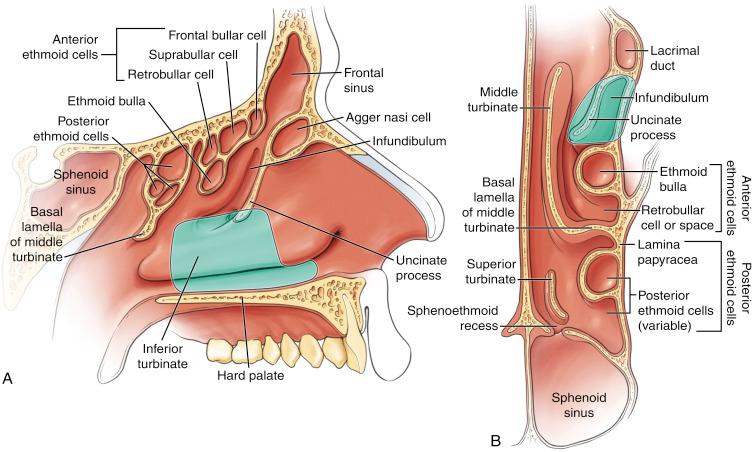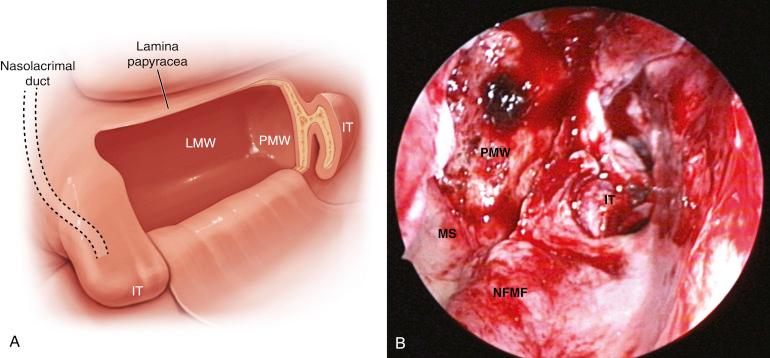Physical Address
304 North Cardinal St.
Dorchester Center, MA 02124
The modified medial maxillectomy entails removing a large portion of the medial maxillary wall to gain wide access to the maxillary sinus. It is primarily used for the removal of benign tumors, such as inverted papillomas and juvenile nasopharyngeal angiofibromas.
The modified medial maxillectomy can also be used to treat chronic maxillary sinusitis refractory to maximum medical management and standard maxillary antrostomy. Modified medial maxillectomy creates a wide opening into the maxillary sinus that may allow improved mucus clearance and better penetration of topical medication and lavages. This procedure can be used in the management of those sinuses in which infected secretions and mucin are persistently found in the floor or along the anterior wall and lateral wall of the sinus. Markedly enlarging the sinus will allow for improved distribution of nasal irrigation and easier access for in-office débridements and suctioning.
This procedure is commonly used for chronic maxillary sinusitis associated with cystic fibrosis, biofilms, extensive allergic mucin, or polyps of the anterior wall and floor of the sinus.
The procedure is also useful for treatment of chronic maxillary sinusitis caused by prolapsed orbital fat from previous medial orbital decompression surgery or inflammation from previous mucosal stripping from other sinus procedures (e.g., Caldwell-Luc).
Modified medial maxillectomy differs from a traditional endoscopic medial maxillectomy by preserving the nasolacrimal duct and a portion of the inferior turbinate.
The lateral nasal wall includes the inferior turbinate, infundibulum (with maxillary ostium), uncinate process, and nasolacrimal duct.
The boundaries for a modified medial maxillectomy are the nasolacrimal duct anteriorly, the posterior maxillary wall posteriorly, the nasal floor and inferior turbinate medially, the lateral maxillary wall laterally, the agger nasi cell and lamina papyracea superiorly, and the maxillary sinus floor inferiorly ( Figs. 15.1 and 15.2 ).


The nasolacrimal duct runs anteriorly in the bony lateral nasal wall and empties into the inferior meatus (Hasner valve) just inferior to the attachment of the inferior turbinate.
The inferior turbinate spans the length of the nasal cavity. The majority of the maxillary sinus cavity lies inferior to the superior attachment of the inferior turbinate to the lateral nasal wall. Removal of the midportion of the inferior turbinate significantly improves exposure of the maxillary sinus.
If pathology or inflammatory disease exists in other sinuses, these areas can be addressed before or after performing a modified medial maxillectomy depending on the indication or exposure.
Study both the axial and coronal computed tomography (CT) scans.
Identify the course of the nasolacrimal duct and its position in the lateral nasal wall.
Identify the extent and origin of the tumor preoperatively so that appropriate instrumentation can be made available for adequate removal, including angled endoscopes, microdébriders, and drills.
0-degree and 30-degree endoscopes
45-degree or 70-degree endoscope to remove allergic mucin or polyps along the anterior or lateral maxillary wall
Curved and straight Beaver blades
J-curette
Suction Freer elevator
Turbinate scissors
Through-cut instruments (Blakesley, backbiting, side-biting)
15-degree drill
Small hemostat
Suction Bovie electrocautery
Raising a medially based mucosal flap off the floor of the nasal cavity allows complete coverage of the exposed bone of the inferior maxillary ridge and helps prevent postoperative crusting and contracture.
Become a Clinical Tree membership for Full access and enjoy Unlimited articles
If you are a member. Log in here